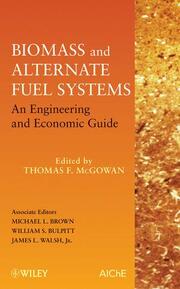Detailansicht
Alternate Fuels, Biomass Energy and Heat Recuperation to Save Energy and Reduce Greenhouse Gases in Industrial Applications
An Engineering and Economic Guide
ISBN/EAN: 9780470410288
Umbreit-Nr.: 1911547
Sprache:
Englisch
Umfang: 280 S.
Format in cm:
Einband:
gebundenes Buch
Erschienen am 29.04.2009
Auflage: 1/2009
- Zusatztext
- InhaltsangabePreface. Acknowledgements. Chapter 1: Introduction to Alternate Fuels. Chapter 2: Fuel Properties and Combustion Theory. Chapter 3: Liquid Fuels from Biomass. Chapter 4: Biomass Combustion Equipment - Steam, Hot Oil, and Hot Gas. Chapter 5: Biomass Fuel Storage and Handling. Chapter 6: Cogeneration and Power Generation. Chapter 7: Emissions and Control. Chapter 8: Environment and Safety: Rules, Regulations and Safe Practice. Chapter 9: Biomass Fuel Supply and Purchasing. Chapter 10: Fuel Switching Feasibility Study Methodology. Chapter 11: Economic Analysis of Biomass Combustion Systems. Chapter 12: Biomass Fuel Processing Routes and Economics. Chapter 13: Biomass Fuel Processing Network. Chapter 14: Example Feasibility Study. APPENDICES. 1. Equipment Manufacturers/Vendors Listing. 2. State Forestry Commission Offices. 3. Glossary.
- Kurztext
- Discover how to fully reap the benefits of biomass and alternate fuels Biomass and alternate fuels offer cleaner, renewable ways to produce energy, can greatly reduce operating costs, and are mostly carbon neutral. Biomass and Alternate Fuel Systems: An Engineering and Economic Guide provides readers with an understanding of these environmentally friendly fuels alongside step-by-step guidance for converting these fuels into energy. In addition to biomass, the book covers such alternate fuels as wood, biogas, reclaimed oil, used tires, cooking oil, solid wastes, and coke. Case studies help readers understand how they can install and operate energy systems to reap all the benefits of biomass and alternate fuels. Everything readers need to know to take full advantage of biomass and alternate fuels is covered, including: * Choosing and installing the right equipment to convert fuels into energy * Evaluating the impact on capital, operating, and production costs * Limiting emissions with pollution control equipment * Using heat exchangers effectively * Comparing the costs and carbon emissions of conventional and alternate fuels * Complying with EPA and OSHA regulations The need for renewable, alternate energy systems has never been greater. With Biomass and Alternate Fuel Systems, readers have a "how-to" manual that enables them to choose the right fuel and install the right energy system to meet their organization's particular needs.
- Autorenportrait
- Thomas F. McGowan is President and founder of TMTS Associates Inc., a firm that specializes in thermal systems and air pollution control. He has thirty-five years of experience in combustion, air pollution control, solids handling, and industrial ventilation. Michael L. Brown is a Senior Engineer at the Georgia Institute of Technology's Enterprise Innovation Institute in the Energy and Sustainability Services Division. His work includes energy efficiency and conservation, energy management projects, and alternate energy projects including studies on production of densified wood pellets. William S. Bulpitt is a Senior Research Engineer for the Georgia Institute of Technology's Strategic Energy Institute. His current work includes research in renewable and transitional energy with utilities and industry. James L. Walsh, Jr. is a Senior Engineer at the Georgia Institute of Technology. With more than forty years of professional experience in design engineering, applied research, technical assistance, and training, he specializes in energy conversion, waste conversion, environmental compliance assistance, and the design, operation, and analysis of pollution control systems.
